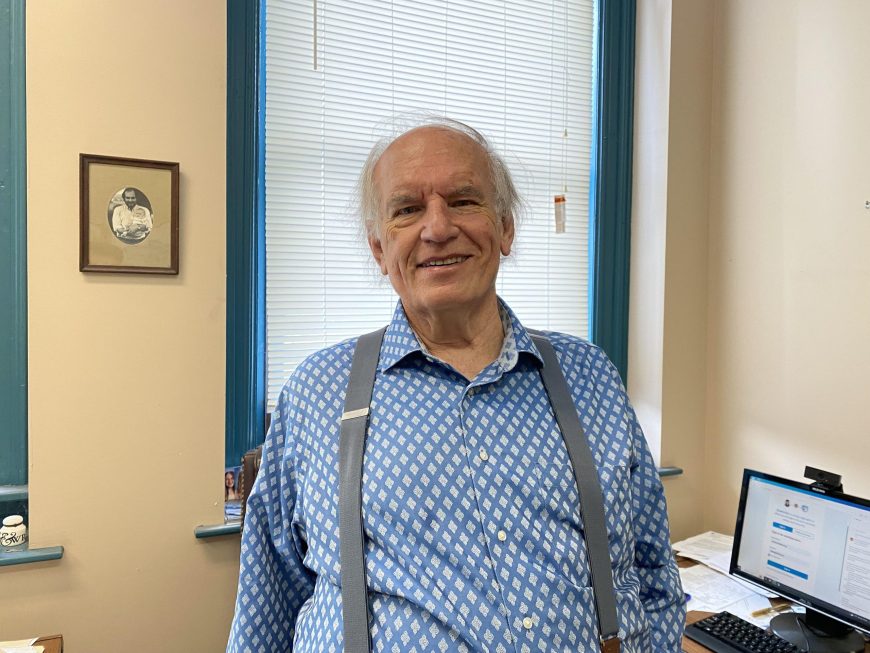
Posted: August 16, 2023 11:49 am
After 44 years, Richard Burkert is calling it a career. The president and CEO of the Johnstown Area Heritage Association (JAHA) today announced his retirement effective August 31, although he will continue to serve JAHA in a consultant role. Patty Carnevali, who came onboard as JAHA’s COO in March, succeeds him as president and CEO immediately.
“I’m excited about JAHA’s future under Patty’s leadership — my enthusiasm for the organization is at an all-time high,” said Burkert, who stepped down to a part-time schedule in March in preparation for this transition. “I’ve been very, very fortunate to spend my entire career here in Johnstown.”
Hired as the executive director of what was then known as the Johnstown Flood Museum Association in 1979, Burkert’s first major achievement was reopening the Johnstown Flood Museum with all-new exhibits in 1989. The documentary Charles Guggenheim had been commissioned to create for the museum on the flood story won the 1989 Academy Award for Best Documentary – Short Subject. (In fact, Burkert briefly appears in a re-enactment portion of the documentary himself as a member of the South Fork Fishing & Hunting Club.)
“David McCullough referred to the renovated museum as ‘one of the best regional museums in the country,’ and of course there was the Academy Award,” noted Dan Solomon, chair of the JAHA Board of Directors. “With that, Richard set the bar for what has been an extraordinary career in Johnstown, using our shared history to be a vital part of our future. Few people have done as much for Johnstown.”
Under Burkert’s leadership, JAHA expanded the scope of its programs to include the themes of iron and steelmaking, immigration, and ethnicity in 1990. The organization’s focus on presenting live music and events began that year too, when JAHA worked with state and local officials to bring the National Folk Festival to Johnstown for three years – and afterward, JAHA began presenting the Johnstown FolkFest, the predecessor festival to the AmeriServ Flood City Music Festival.
“Richard’s vision was critical in establishing the festival in Johnstown, and he has a knack for getting people on board with his ideas and getting them to work with him over the long haul,” observed Ron Carnevali, who began volunteering on the festival in 1992 and is still the event’s co-chair. Carnevali, who was a longtime member of the JAHA board of directors, was instrumental in the development of Peoples Natural Gas Park. “Development timelines for projects like Peoples Natural Gas Park are long, and it takes vision and perseverance to see them through. Richard has succeeded again and again.”
In 1991, Burkert led the development of the “Johnstown Heritage Development Plan,” which called for the development of a linked system of attractions themed on Johnstown’s history. The plan included a Heritage Discovery Center, a “festival park,” local historic preservation guidelines, and the River Edge Greenway (now known as the Iron to Arts corridor) linking Cambria City and the Lower Works to downtown Johnstown. Burkert then got to work on the development of what is now called the Johnstown Discovery Network, which today includes:
Burkert has been instrumental in numerous other preservation and community development projects, including the conservation of Morley’s Dog, a relic of the Johnstown flood; the Cambria City Design Charettes of 2009 and 2011 that assisted the process of transferring the ownership of historic, vacant church properties to 1901 Church (the Steeples Project); the registration of six Johnstown area communities as National Historic Districts; the establishment of the Clara Barton House & Gardens; and the founding of the Johnstown Slavic Festival.
Burkert will continue in a consultant role at JAHA, where he will serve on the board of directors. He will maintain an office at the Heritage Discovery Center, where he will continue to work on the rehabilitation of the Johnstown Flood Museum and renovation of the Train Station, as well as the development of new exhibits.
Patty Carnevali, JAHA’s new president and CEO, originally came to Johnstown in 1990 to serve as the first executive director of the Pasquerilla Performing Arts Center at UPJ. She first got to know JAHA as a volunteer for the AmeriServ Johnstown FolkFest back in the 1990s. From 2010-2013, she served as JAHA’s associate vice president for external relations and events. Carnevali, who holds a master of arts in arts administration, was most recently the executive director of the Mountain Playhouse. She has also served as house manager for the Johnstown Symphony Orchestra.
“JAHA will still make good use of Richard’s historical expertise and many years of experience,” Patty Carnevali said. “We are grateful for his many years of service in creating this organization, and will work hard to continue his legacy.”
“You can’t shake your heritage – it’s part of who you are, and it’s part of the character of your community. But you can use it to create a strong sense of place, and successful communities do,” Burkert has said. “There’s no place quite like Johnstown.”